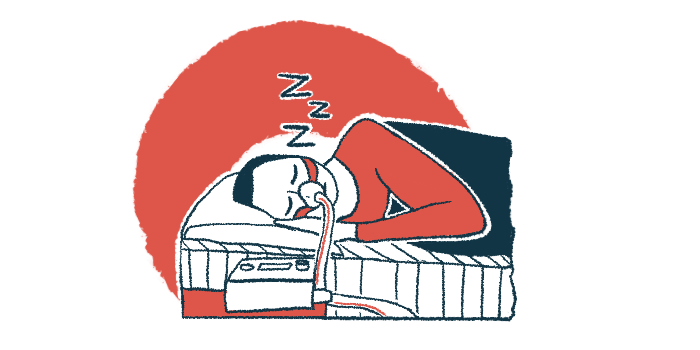Opioid use greater for ALS patients on noninvasive ventilation: Study
But symptom relief even with such drugs still found to be limited

People with amyotrophic lateral sclerosis (ALS) who require noninvasive ventilation in later disease stages use significantly higher opioid doses and for more extended periods than do patients who never need mechanical ventilation, according to a new study in Japan.
The opioids were started for these individuals mostly to help minimize shortness of breath and ease pain. But several patients included in the single-center study never reached a stable dose, and most also needed anxiolytics and antidepressants to aid in symptom control.
These findings suggest “that there are limits to the relief of distress with opioids alone,” the researchers wrote, noting that patients whose respiration is managed with noninvasive ventilation may have other issues causing distress.
“Symptom control with opioids alone may be difficult, and the development of multifaceted evaluation and care is desirable,” the team wrote.
The study, “High doses of opioids usage for amyotrophic lateral sclerosis patients with non‑invasive ventilation,” was published in the journal Acta Neurologica Belgica.
Opioid use started for most patients for breathing difficulties
ALS is caused by damage and death of motor neurons, the nerve cells that control voluntary movement. With the loss of these cells, the brain can no longer control muscle movements, and patients progressively lose their ability to perform everyday tasks.
In the later stages of the disease, paralysis usually occurs, leading to pain, and a vast number of patients also experience difficulty breathing. These symptoms contribute to a great degree of distress in about 40%-70% of people with ALS, according to researchers.
The use of a ventilator to support breathing can extend survival in patients, studies have shown. But the distress associated with breathing problems is still difficult to treat, the researchers say.
“The [noninvasive ventilation] group needed psychotropic drugs more frequently than the no-[mechanical ventilation] group,” the team wrote. Such mental health treatments include antidepressants and antianxiety medications, as well as stimulants, antipsychotics, and mood stabilizers.
Morphine, a type of opioid mainly used to treat pain, may be helpful for some patients in easing the pain and distress caused by labored breathing in ALS. Still, “only a few studies have addressed morphine dosing in ALS patients, with a limited number of cases,” the researchers wrote.
There are limits to the relief of distress with opioids alone.
To clarify how opioids are use to treat symptoms of ALS, researchers in Tokyo examined data from 84 patients treated with morphine at their hospital. All of the patients were followed up until their death. Each received the opioids between January 2010 and December 2018 and died in that period, mainly due to respiratory failure.
Among these patients, 57 (67.9%) did not use mechanical ventilation, 21 (25%) used noninvasive ventilation (NIV) — the delivery of oxygen using a face mask — and four (4.8%) underwent tracheostomy invasive ventilation (TIV), an opening in the trachea to insert a tube that delivers oxygen to the lungs. Two patients only underwent tracheostomy.
“All the deceased patients were eventually given some form of oxygen,” the researchers wrote.
Opioid use for most patients on noninvasive ventilation spanned 13 months
Patients received morphine mainly orally or directly to the stomach via a tube inserted in the abdomen, but there were some for whom morphine was delivered by intravenous or in-the-vein administration or via skin patches.
Results showed that patients in the NIV group lived about 10 more months after their diagnosis, on average, than those who used no mechanical ventilation. But the NIV group required a significantly higher opioid dose — 65.7 mg versus 31.7 mg — and used these drugs for significantly longer periods, specifically 13.3 months versus 1.7 months.
“This result indicates that the no-[mechanical ventilation] group received opioids only for a short time before death,” the researchers wrote.
This was supported by the fact that 34.5% of the patients in the no-mechanical ventilation group were started on opioids one month before their death, compared with 10% of the individuals in the NIV group.
The researchers noted that a larger proportion of patients given NIV (33%) never reached a stable opioid dose, compared with 21% of the patients without mechanical ventilation. But when only patients on stable doses were included, those in the NIV group continued to use significantly higher doses than those who did not use mechanical ventilation (29.2 vs. 19 mg).
The most common symptom leading to opioids use was shortness of breath in both groups, although it was more predominant in the no-mechanical ventilation group than in the NIV group (91% vs. 57%). Other reasons included pain, anxiety, and restlessness.
Finally, patients in the NIV group needed psychotropic medications more frequently than the no-mechanical ventilation group, and the most commonly used medications were benzodiazepines, used to ease anxiety and insomnia, and antidepressants.
Although opioid and psychotropic drug use was low in the TIV group, or those given an opening in the trachea, the results do not indicate that these patients require less opioid treatment because they are less distressed, the researchers noted. Still, analyses in this group were hampered by a reduced number of patients with TIV, mostly because patients on TIV usually survive longer.
“What happens in this group of long-term survivors and what kind of care is needed is not yet fully understood, and needs further study,” the researchers wrote.








